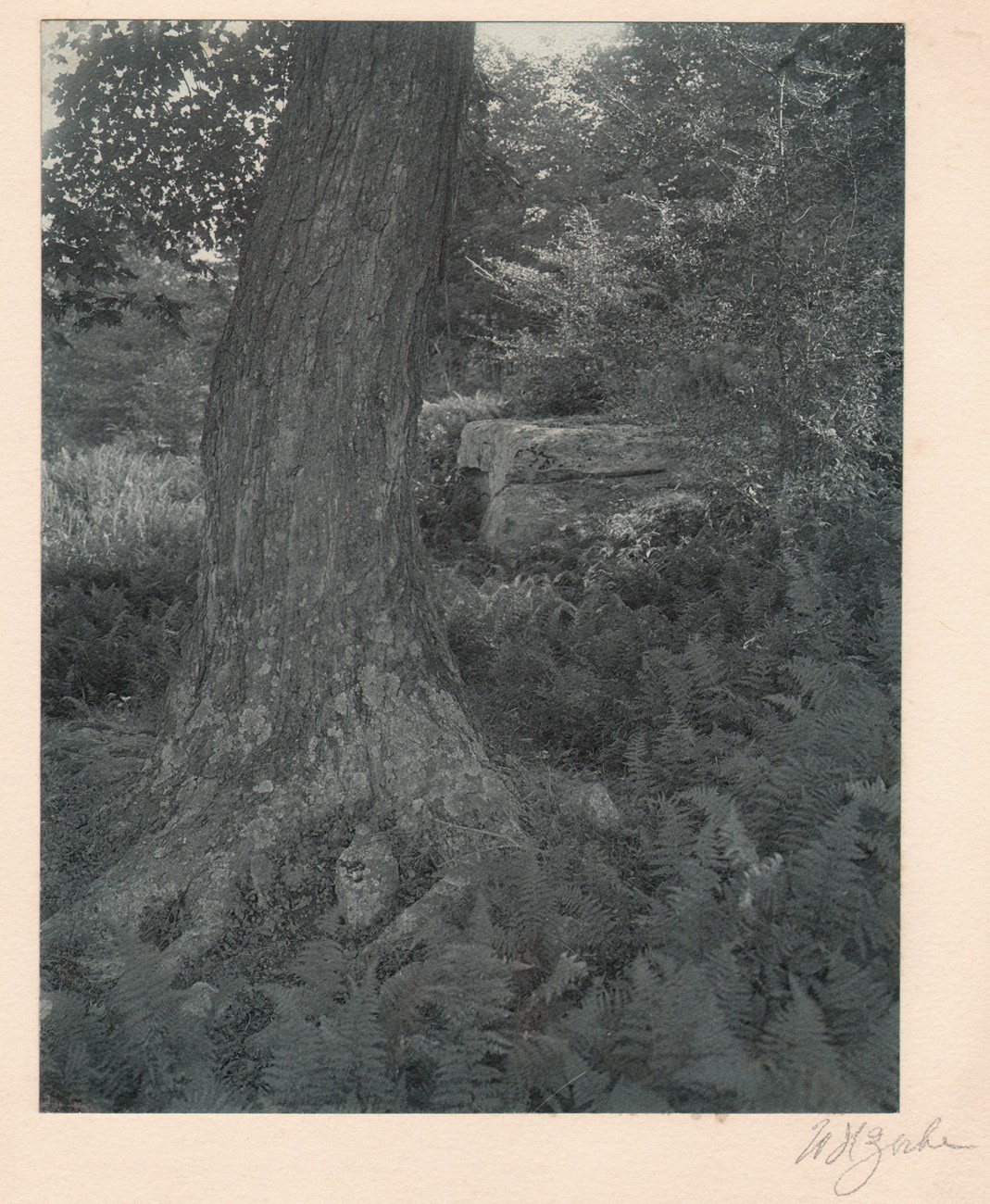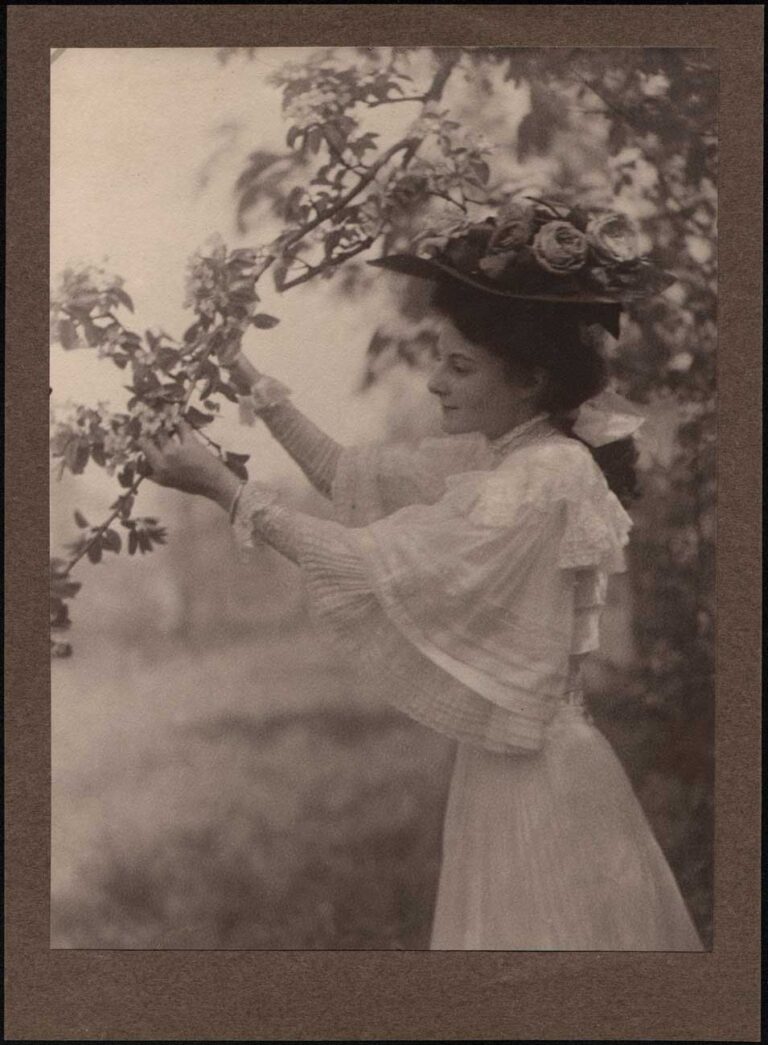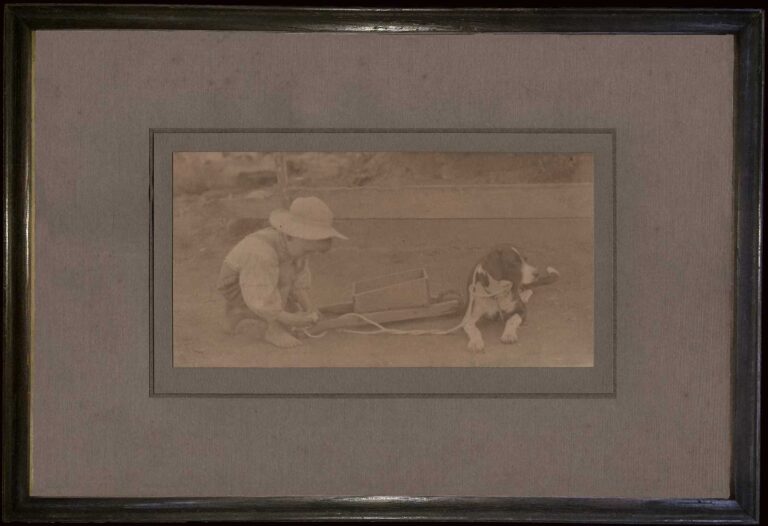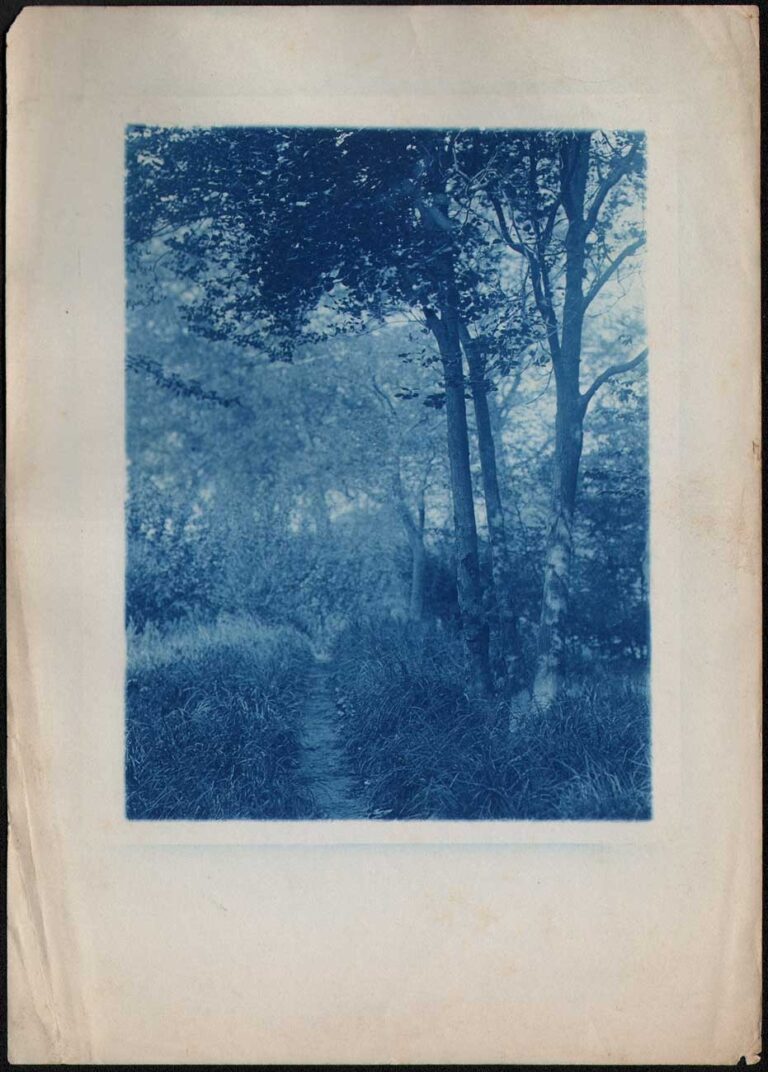
A Veteran of the Forest
Stretching the metaphor in a different direction, the title of this early tree study by photographer William H. Zerbe of Richmond Hill, Long Island, New York, might be re-titled: Veteran of Photography. That’s because Zerbe’s entire life was devoted to the art and craft he loved. Zerbe was not only a working newspaper photographer his entire adult life, he was a committed fine-art photographer working in the pictorialist aesthetic well into his late 70s. Zerbe did it all. He was elected a Fellow of the Royal Photographic Society (F.R.P.S.) and The Photographic Society of America; (FPSA) and from 1910 until at least 1941, he was a photographic instructor and lecturer in the Department of Photography of the Brooklyn Institute of Arts and Sciences. In addittion to all this, he was a founding member of the New York Press Photographers Association, and a well-regarded, sought-out judge for photo salon competitions.
In 1921, Zerbe provided a first-person account of his introduction to photography titled My First Photograph, in Photo Era Magazine. The article is instructive for background on his early career, stating 1883 was when it all began:
“When the photographic bee first began to buzz around me, I was employed in the works of Andrew Prosch, who, with his brother George, made the first photographic camera in this country. This was for Prof. Samuel F. B. Morse, the inventor of the telegraph. At this time, George Prosch had long been dead, but Andrew continued the business, making various kinds of photographic apparatus for E. & H. T. Anthony & Co., Scovill & Adams Co., and others in the photographic supply-business. Besides doing work for these regular firms, quite a large business was done in making special apparatus for a number of wealthy people who had taken up amateur photography, since the advent of the dryplate, as a hobby. These amateurs used to congregate in our shop and talk photography, and show and exchange pictures.
Being in this photographic atmosphere constantly, it was but natural for the bug to bite me. Working for a small salary, I could not afford to buy any of the amateur-outfits then on the market, so I bought a Scovill & Adams double plateholder and built a complete outfit around this. The bellows was not of the accordion type, but just a plain, collapsible cone. For a lens, I bought a second-hand opera-glass, mounting one of the large lenses in a brass tube.
My shutter was of the drop-shutter type, arranged so that it could be opened and closed with a string operated at a distance. With this outfit operated in the manner described, the accompanying photograph, my very first, was made. The photograph shows myself and five brothers. The youngest shown in the picture is now the father of a family of six, one of whom has put in his first vote. The picture was made, to be exact, in 1883.” (1.)
Beginning in 1904 and exhibiting as W.H. Zerbe Jr., he made a big name for himself while winning multiple awards as a member of The Brooklyn Camera Club, including the President’s Cup in their Spring exhibition contest judged by among others, Gertrude Kasebier. (2) By 1906, he was a member of the upstart American Photographic Salon, and a fellow director along with founder Curtis Bell of the Salon’s organizing body, The Metropolitan Camera Club of New York. (3) He was also involved that year with the Third Annual installment of the Salon’s annual exhibition, being a member of the preliminary jury as well as committee member. (4) By 1908, Zerbe was the Director for two American Photographic Societies, based in his Long Island home at 345 Spruce Street in Richmond Hill- Associates in Pictorial Photography and the Salon Club. The first group, most likely made up of amateur photographers from the greater Metropolitan New York area, featured 22 members who circulated a monthly portfolio of work among themselves. They each contributed work and wrote criticism as “Associates”- passing both along every month to their fellow club members. The Salon Club’s membership was limited to 50 members and was from a wider geography, as W. and G. Parrish were its’ secretaries based in St. Louis. (5) It is believed the examples of Zerbe’s photographs presented on PhotoSeed come from these circulating portfolios, (1905-1910) as his Spruce Street label are present on the verso of these vintage mounted photographs.
Born in Brooklyn, New York, William Henry Zerbe (1864- January 5, 1943) began his professional career as a photographer in 1907 at Brown Brothers in New York City, staying four years. From 1913-1920, his newspaper photography career commenced at The New York Herald. (6) From the Herald, he went to the New York Daily News, working from 1920-1922 before going back to the Herald. He continued with them until 1924 when the merger of the Herald and New York Tribune created the newly formed New York Herald Tribune. (7) Zerbe stayed on board after the merger, continuing with the paper until sometime late in 1942. A New York Times obituary notice indicated Zerbe had been ill for six weeks prior to his passing at his home in Richmond Hill on January 5, 1943. (8) Earlier, in May, 1941, an in-depth, photographically illustrated profile appeared in Popular Science magazine on Zerbe, describing him as a “trim, gray, smiling little man” who had first begun taking photographs in 1884. (9) The interview is required reading for anyone interested in learning more about Zerbe, and begins with the following introduction:
“A News photographer by profession, a photographic artist by choice, William H. Zerbe has been taking pictures since 1884 both as a business and a hobby.
Today, still an active member of the staff of the “New York Herald Tribune,” he ranks as a dean in both fields-a veteran among news cameramen and salon exhibitors alike. His own prints, many of them made on day-by-day journalistic assignments, have been exhibited in outstanding photographic salons all over the world. And for many American salons he has been chosen as a member of the judging committee.” (10.)
References come across during the research for this brief profile indicate he was much loved and respected by the people who came to know him during his lifetime. These included many fellow photographers in both the newspaper and salon world. Several photographers in the history of the medium- Edward Steichen and Clarence White- (before his untimely passing) come to mind because of their passion and work ethic. Zerbe would seem a logical fit to this fraternity based on those two qualities alone. A lasting and amusing tribute to him, written by Photographic Society of America associate member Stanley A. Katcher, was reprinted in the Brooklyn Eagle newspaper after first being published in the PSA’s journal one month after his passing:
“In the February issue of the Journal of the Photographic Society of America, Stanley A. Katcher paid tribute to the late William H. Zerbe in an original and touching letter. I knew Mr. Zerbe well, and that is why I thought you would like to read these excerpts from Mr. Katcher’s very human document, which is printed below”: (11)
William H. Zerbe,
Heavenly Photographic Studios,
Universe.
“Dear Bill- Some of the fellows were talking about you the other day and I thought it a good idea to drop you a line, because, although you haven’t been gone very long, we’ve really missed you a lot. “Funny part of it is that none of the gang is really wailing about your leaving, for most of us felt that you deserved a vacation if ever a man did, and it would have been awfully selfish of us to begrudge it to you.
“You’d probably like to know that the consensus around here is that you’re quite a paradox; “Here you were, earning your livelihood as a photographer and really working hard at it, and yet your hobby was photography. Doctors say that a man’s avocation should be different from his daily tasks, but you sure exploded that theory with your 78 years, and remaining just as spry and active as the youngest of us.
“Remember that Sunday only last Summer when we went on that camera train together? I got quite a kick out of you that day. After chasing pictures for the New York Herald Tribune all week there you were on your day off searching for pictorial shots for your own satisfaction and pleasure, and- traveling miles just to reach a good spot with possibilities. When you posed that farmer up against a gate I had to laugh to myself watching a grizzled veteran like you being just as enthusiastic as a kid with his first camera. And I want to tell you that I was puffing when we got to the top of that hill we climbed just to see if there was anything photogenic on the other side.
“What really impressed me that day was the fact that everybody on the train knew you so well. Usually, there’s an unbridgeable gap between a youngster and a chap your age, but somehow or other you seemed to be just one of them. Mind you, not that they lacked respect for you, but they just didn’t talk to you with that peculiar reserve they have for older people, especially when the older person has collected your bunch of honors and distinctions.
“Personally, I think it was because you were with them so much that made them feel close to you, even if you were a Fellow of PSA and The Royal. You used to go to their camera clubs, and all their functions, so often, that you were like as one of their members yourself. For a busy photographer you sure did get around.”
The press photography gang were vociferous in stating that we pictorialists always claim too much credit for you, when they really are entitled to the lion’s share. I can’t argue with them because it is true that you and a few others founded the New York Press Photographers Association 25 years ago. Its standing today certainly is a tribute to your foresight. They say I can talk my lungs out but you’re still one of them and nothing else.
They still talk of that time back in 1919 when you covered the Dempsey-Willard fight, and used a plane to get the pictures back to New York in a hurry. Old stuff now, perhaps, but it certainly took courage in those days to trust your films to a flying crate.
No sense going into ancient history, but is it really true you began working in a photo supply house in 1880? I didn’t even know they had those things then. How could you keep it up all these years? Didn’t your interest ever wane? I know it didn’t, but it sounds unbelievable.
Sincerely,
Stanley A. Katcher, APSA. (12.)
Print details: verso:
pre-printed, Zerbe letterpress, tack-glued label: 9.5 x 12.2 cm:
PHOTOGRAPHS FROM
WILLIAM H. ZERBE,
345 SPRUCE ST., RICHMOND HILL, L. I
title: typewriter-written: A Veteran of the Forest
Print support recto: pencil-signed: WH Zerbe at lower right corner in margin below mounted print.
Notes:
1. My First Photograph: by William H. Zerbe: in: Photo Era Magazine: The American Journal of Photography: Published by A.H. Beardsley: Wolfeboro, New Hampshire: Vol. XLVII, November, 1921: p. 238 : (at the time, the Andrew Prosch firm was located at 36 Platt street in Manhattan)
2. Society News: in: The American Amateur Photographer: Volume IV: New York, N.Y. : The American Photographic Publishing Company: Volume XV: June, 1906: p. 284
3. With the Camera Clubs: in: The American Amateur Photographer: Volume IV: New York, N.Y. : The American Photographic Publishing Company: Volume XVIII: May, 1906: p. 246
4. Notes, News and Extracts: in: The Photographic Times-An Illustrated Monthly magazine devoted to the interests of Artistic and Scientific Photography: Edited by W.I. Lincoln Adams and Charles H. Plump: The Photographic Times Publishing Association: New York: Volume XXXVIII, September, 1906: p. 422
5. American Photographic Societies: in: The American Annual of Photography: Edited by John A. Tennent: Tennant and Ward: New York: p. 325, 328
6. Obituary: in: The New York Times: January 6, 1943
7. Ibid
8. Ibid
9. What a Picture Judge Looks for in a Print: Popular Science interviews photographer William H. Zerbe: in: Popular Science: Charles McClendon, Editor: Popular Science Publishing Company Inc. : New York: May, 1941: pp. 206-209 (the 1884 date mentioned in this article differs from the 1883 date Zerbe stated in his 1921 article for Photo Era Magazine)
10. Ibid: p. 207
11. Camera Clubs: by Robert R. Morris, P.S.A.: in: the Brooklyn Eagle newspaper: Saturday, March 20, 1943: p. 5
12. Ibid. Now based in Oklahoma City, OK, The Photographic Society of America was founded in 1934 from members of the Associated Camera Clubs of America , (ACCA) first chartered in 1919.
Original copy for this entry posted to Facebook on January 15, 2012:
With the fortune of owning two signed photographs by him, I prepared a short profile last year on William Henry Zerbe, (1864-1943) a consummate and important American photographer who as far as I know has escaped any scholarship or mention since his passing almost 70 years ago. I hope to change that a bit with this short profile I fleshed out for PhotoSeed. Simply put, Zerbe was extraordinary in straddling two photographic worlds: as a lifelong working newspaper photographer in New York City- a founding member of the New York Press Photographers Association no less as well as a Fellow and active exhibitor in the Royal Photographic Society and The Photographic Society of America.



